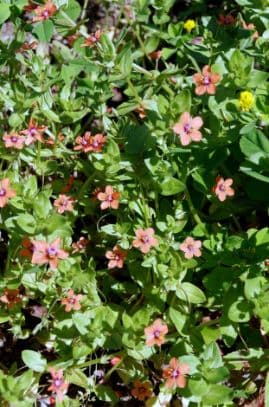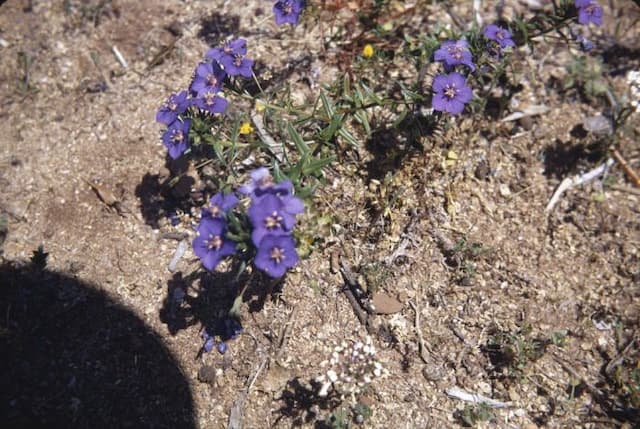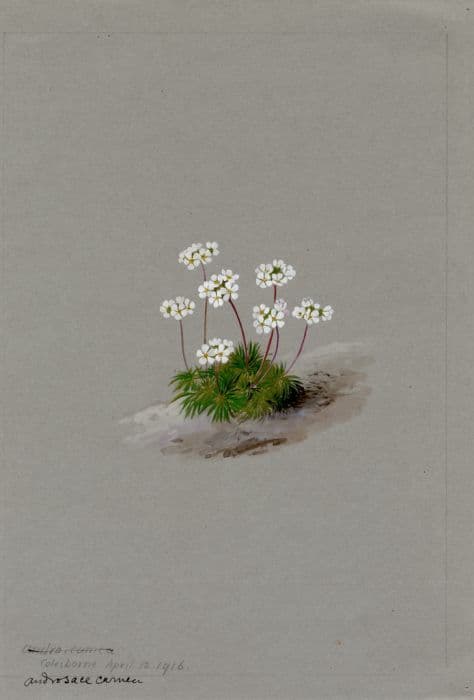Loosestrife Beaujolais Lysimachia atropurpurea 'Beaujolais'

ABOUT
The plant known as Loosestrife 'Beaujolais' displays an elegant and striking appearance. It is characterized by its tapering spires of deep purple to burgundy flowers, which impart an air of sophistication and depth to the garden space. These tiny, cup-shaped blossoms are tightly clustered around the stem, creating a columnar effect that adds vertical interest. The foliage of the Loosestrife 'Beaujolais' provides a contrasting backdrop to its dark flowers, featuring slender leaves that are grayish-green in color. This silver-green foliage often takes on a metallic sheen, making it an attractive feature even when the plant is not in bloom. The leaves are arranged in a whorled pattern around the stems, adding texture and density to the plant's overall form. The combined aesthetic of the richly colored flowers and the understated elegance of the leaves gives Loosestrife 'Beaujolais' a regal presence in a garden setting. It tends to have a somewhat upright, clumping growth habit, and the flower spires extend upwards, providing an alluring focal point throughout its blooming season. Furthermore, the blossoms can also attract pollinators, adding a dynamic element to its appearance as bees and butterflies visit the flowers. Overall, Loosestrife 'Beaujolais' is a visually appealing plant that brings dramatic color and graceful form to any garden landscape.
About this plant
 Names
NamesFamily
Primulaceae.
Synonyms
Loosestrife 'Beaujolais', Purple Loosestrife 'Beaujolais', Beaujolais Loosestrife, Burgundy Loosestrife.
Common names
Lysimachia atropurpurea 'Beaujolais'.
 Toxicity
ToxicityTo humans
The plant known as 'Loosestrife' is not typically considered toxic to humans. There is no widespread documentation or significant concern regarding its toxicity. Therefore, ingestion of the plant is unlikely to cause harm, but as with any plant not typically meant for consumption, it's still prudent to exercise caution and avoid eating them.
To pets
Loosestrife is not commonly listed as a toxic plant to pets. It should be safe around cats and dogs, and there aren't well-documented cases of poisoning from this plant. Nevertheless, keeping an eye on pets and discouraging them from eating plants is always a good practice, as individual animals may have unique sensitivities.
 Characteristics
CharacteristicsLife cycle
Perennials
Foliage type
Deciduous
Color of leaves
Green
Flower color
Purple
Height
2 feet (60 cm)
Spread
1 foot (30 cm)
Plant type
Herb
Hardiness zones
5
Native area
Southeastern Europe
Benefits
 General Benefits
General Benefits- Attracts Pollinators: Lysimachia atropurpurea 'Beaujolais', commonly known as Loosestrife, is known to attract bees and butterflies, which are vital for pollination.
- Low Maintenance: Loosestrife is a plant that requires minimal care, making it ideal for gardeners seeking low-maintenance gardening options.
- Drought Tolerant: Once established, Loosestrife can tolerate periods of dryness, reducing the need for frequent watering.
- Visual Appeal: With its tall spikes of deep burgundy flowers, Loosestrife adds an element of elegance and a unique color palette to any garden setting.
- Long Blooming: Loosestrife has a long flowering period, providing color and interest in the garden from early to mid-summer.
- Deer Resistant: Loosestrife is typically not a preferred food source for deer, making it a good choice for gardens in areas with deer populations.
- Good Cut Flowers: The stems of Loosestrife hold up well in floral arrangements, offering both longevity and visual interest in cut flower displays.
- Versatile Use: Loosestrife can be used in borders, cottage gardens, or as a striking feature in a wildflower meadow.
 Medical Properties
Medical PropertiesThis plant is not used for medical purposes.
 Air-purifying Qualities
Air-purifying QualitiesThis plant is not specifically known for air purifying qualities.
 Other Uses
Other Uses- Lysimachia 'Beaujolais', commonly known as Loosestrife, can be used as a natural dye for fabrics, giving them a unique range of purplish hues.
- In arts and crafts, the tall, elegant stems and richly colored flowers of Loosestrife can be incorporated into dried flower arrangements and potpourri blends.
- Loosestrife can be used in environmental education programs to illustrate the concept of garden aesthetics and the importance of perennial plants for sustainable design.
- The tight clumping growth habit of Loosestrife makes it a good choice for creating borders or edges in gardens and landscaping projects.
- Due to its attractive appearance, photographers and painters may use Loosestrife as a subject to explore the theme of natural beauty in their art.
- Loosestrife can be beneficial for erosion control because its roots can help stabilize soil in sloped areas of a garden or landscape.
- It can be used in sensory gardens for its texture and color contrast, providing an experience that is pleasing to the eye and engages the sense of sight.
- Culinary artists may use the flowers of Loosestrife as an edible garnish for desserts and specialty drinks, though it is not widely recognized as a traditional food item.
- Gardeners may use the plant's growing pattern as an example for teaching about the natural growth habits and care requirements of perennial herbaceous plants.
- Loosestrife can be planted to provide support for declining bee populations, as it is a nectar-rich plant that attracts pollinators.
Interesting Facts
 Feng Shui
Feng ShuiThe Lysimachia is not used in Feng Shui practice.
 Zodiac Sign Compitability
Zodiac Sign CompitabilityThe Lysimachia is not used in astrology practice.
 Plant Symbolism
Plant Symbolism- Persistence: Lysimachia atropurpurea, commonly known as 'Beaujolais', typically grows in tough conditions and is resilient in various environments, symbolizing the ability to persist through challenges.
- Harmony: The plant often settles comfortably into its surroundings, growing in harmony with other plants, representing the desire for balance in one's life.
- Attractiveness: With its striking purple-red flowers, the 'Beaujolais' variety symbolizes the allure and beauty found in nature, as well as personal attraction and charm.
- Regeneration: As a perennial, it dies back in winter and regrows in spring, symbolizing renewal and the cyclical nature of life.
- Humility: Despite its beauty, Lysimachia atropurpurea tends to grow without overpowering its surroundings, thus it can be seen to symbolize modesty.
 Water
WaterThe Loosestrife 'Beaujolais' prefers consistently moist soil, so it should be watered thoroughly whenever the top inch of soil begins to dry out. This typically means watering once or twice a week, depending on the climate and weather conditions. Use deep watering methods, allowing water to reach the roots by applying it slowly at the soil level. A good measure for outdoor plants is roughly 1 gallon of water per week, but this may need to be increased during hot, dry periods or reduced during rainy seasons.
 Light
LightLoosestrife 'Beaujolais' thrives in full sun to partial shade. It performs best when it receives at least six hours of direct sunlight each day. The ideal spot for this plant would be in an area that gets morning sunlight and some afternoon shade to protect it from the intense heat later in the day.
 Temperature
TemperatureLoosestrife 'Beaujolais' prefers moderate temperatures and can generally tolerate conditions between 50°F and 85°F. While it can survive brief periods of colder weather, frequent exposure to temperatures below freezing (32°F) can be detrimental. The ideal growing temperatures for this plant are in the range of 60°F to 75°F.
 Pruning
PruningPruning Loosestrife 'Beaujolais' can encourage bushier growth and prevent the plant from becoming leggy. Prune in the late winter or early spring before new growth begins. Cut back the stems to about a third of their height to promote more robust growth. Seasonal pruning may also include removing spent flowers or any damaged or dead foliage to maintain the plant's appearance and health.
 Cleaning
CleaningAs needed
 Soil
SoilLoamy soil with good drainage is ideal for the Burgundy Loosestrife ('Beaujolais'), with a preferred pH of 5.5 to 7. Incorporate organic matter to enrich the soil and ensure optimal growth.
 Repotting
RepottingThe Burgundy Loosestrife should typically be repotted every 2-3 years or when it outgrows its current pot to refresh the soil and encourage new growth.
 Humidity & Misting
Humidity & MistingBurgundy Loosestrife thrives in average to high humidity environments; avoiding extremely dry conditions will help maintain its vigor.
 Suitable locations
Suitable locationsIndoor
Provide bright light and moist, well-drained soil.
Outdoor
Plant in partial shade to full sun in well-drained soil.
Hardiness zone
4-8 USDA
 Life cycle
Life cycleLysimachia atropurpurea 'Beaujolais', commonly known as Beaujolais Loosestrife, begins its life cycle when seeds are sown in soil under the right conditions of warmth and moisture, typically in spring. Germination occurs, and seedlings emerge, establishing a root system while developing leaves through the vegetative stage. As the plant matures, it enters the reproductive phase, producing tall spikes of rich, burgundy flowers by early to mid-summer. After pollination, often assisted by insects attracted to the flowers, the plant sets seed. The seeds eventually disperse, either by wind or wildlife, and if conditions allow, they will germinate to start a new cycle. In colder climates, Beaujolais Loosestrife dies back in winter but can re-emerge from hardy roots or self-sown seeds the following spring.
 Propogation
PropogationPropogation time
Spring to Summer
The most popular method for propagating the Loosestrife 'Beaujolais' (Lysimachia atropurpurea 'Beaujolais') is through division. It is best done in the spring or autumn when the plant is not in active growth. To propagate by division, carefully lift the plant from the ground with a shovel, maintaining as much of the root system as possible. Gently tease apart the clumps into smaller sections, ensuring each new section has a good amount of roots attached. Replant the divisions at the same depth they were growing at previously and water them well to help establish the new plants. This method allows for the quick establishment of new plants that are genetically identical to the parent plant.









